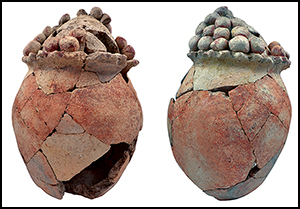Crossref Citations
This article has been cited by the following publications. This list is generated based on data provided by
Crossref.
Horn, Christian
Klimscha, Florian
and
Rosenberg, Danny
2019.
Exploring the dimensions of Chalcolithic settlements in the southern Levant - A geomagnetic survey on Tel Tsaf, Israel.
Journal of Archaeological Science: Reports,
Vol. 24,
Issue. ,
p.
380.
Twiss, Katheryn C.
2019.
The Archaeology of Food.
Rosenberg, Danny
Love, Serena
Hubbard, Emily
Klimscha, Florian
and
Biehl, Peter F.
2020.
7,200 years old constructions and mudbrick technology: The evidence from Tel Tsaf, Jordan Valley, Israel.
PLOS ONE,
Vol. 15,
Issue. 1,
p.
e0227288.
Grosman, Leore
Raz, Timna
and
Friesem, David E.
2020.
Tomorrow’s mundane is today’s extraordinary: A case study of a plastered installation during Neolithization.
Humanities and Social Sciences Communications,
Vol. 7,
Issue. 1,
Freikman, Michael
Ben-Shlomo, David
and
Garfinkel, Yosef
2021.
Architectural Models from Tel Tsaf, Central Jordan Valley, Israel.
Paléorient,
Rosenberg, Danny
Liu, Li
Levin, Maureece J.
Klimscha, Florian
and
Shalem, Dina
2021.
From Hangovers to Hierarchies: Beer production and use during the Chalcolithic period of the southern Levant – New evidence from Tel Tsaf and Peqi‘in Cave.
Journal of Anthropological Archaeology,
Vol. 64,
Issue. ,
p.
101361.
Rosenberg, Danny
Rizzuto, Branden Cesare
Klimscha, Florian
and
Carter, Tristan
2022.
The obsidian beads from Middle Chalcolithic Tel Tsaf (ca. 5,200–4,700 cal. BC), Jordan Valley, Israel: technology, provenance, and socio-economic significance.
Archaeological and Anthropological Sciences,
Vol. 14,
Issue. 6,
Jalilov, Shokhrukh-Mirzo
Rahman, Wakilur
Palash, Salauddin
Jahan, Hasneen
Mainuddin, Mohammed
and
Ward, Frank A.
2022.
Exploring strategies to control the cost of food security: Evidence from Bangladesh.
Agricultural Systems,
Vol. 196,
Issue. ,
p.
103351.
Rosenberg, Danny
Elkayam, Yael
Garfinkel, Yossi
Klimscha, Florian
Vučković, Vesna
Weiss, Yaakov
and
Zerboni, Andrea
2022.
Long-distance trade in the Middle Chalcolithic of the southern Levant: The case of the olivine beads from Tel Tsaf, Jordan Valley, Israel.
PLOS ONE,
Vol. 17,
Issue. 8,
p.
e0271547.
Langgut, Dafna
and
Garfinkel, Yosef
2022.
7000-year-old evidence of fruit tree cultivation in the Jordan Valley, Israel.
Scientific Reports,
Vol. 12,
Issue. 1,
Rosenberg, Danny
Ktalav, Inbar
Groman-Yaroslvski, Iris
and
Klimscha, Florian
2022.
Unique Theodoxus jordani shell beads from the Middle Chalcolithic site of Tel Tsaf (ca. 5200–4700 cal BC), Jordan Valley, Israel.
Archaeological Research in Asia,
Vol. 29,
Issue. ,
p.
100349.
Langgut, Dafna
and
Sasi, Arik
2023.
“And in Length of Days Understanding” (Job 12:12).
p.
39.
Rosenberg, Danny
Galili, Ehud
and
Langgut, Dafna
2023.
The Unseen Record: Ninth–Seventh Millennia Cal. BP Wooden and Basketry Objects from Submerged Settlements off the Carmel Coast, Israel.
Forests,
Vol. 14,
Issue. 12,
p.
2373.
Smith, Patricia
Faerman, Marina
and
Horwitz, Liora Kolska
2023.
“And in Length of Days Understanding” (Job 12:12).
p.
267.
Groman-Yaroslavski, Iris
Barshay, Katerina
Klimscha, Florian
Garfinkel, Yossi
and
Rosenberg, Danny
2024.
Sickle construction technologies at Middle Chalcolithic Tel Tsaf, Jordan Valley, Israel.
Archaeological and Anthropological Sciences,
Vol. 16,
Issue. 2,
Nag, Mukesh Kumar
2024.
Development and inner environment analysis of advance and eco-friendly cementitious silo for postharvest grain protection and shelf life extension for medium and small-scale farmers.
Journal of Stored Products Research,
Vol. 106,
Issue. ,
p.
102290.
Joffe, Alex
2024.
Textiles and Staple Finance in the Near East and the Southern Levant.
Cambridge Archaeological Journal,
Vol. 34,
Issue. 4,
p.
793.
Hruby, Karolina
Klimscha, Florian
and
Rosenberg, Danny
2024.
The Tel Tsaf decoration: Contextualizing a Chalcolithic pottery phenomenon on a regional scale.
Archaeological Research in Asia,
Vol. 40,
Issue. ,
p.
100541.
Langgut, Dafna
2024.
The core area of fruit-tree cultivation: central Jordan Valley (Levant), ca. 7000 BP.
Palynology,
Vol. 48,
Issue. 4,



